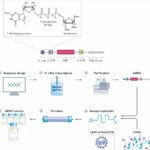 In the world of particle physics, big accelerators have always been the go-to tools for pushing particles to incredible speeds. These massive machines, with their sprawling tracks and powerful magnets, are not just costly but also quite bulky. Now, there’s a game-changing technology on the horizon: laser-plasma acceleration. This approach aims to shrink the size and cost of particle accelerators, making them more accessible.
In the world of particle physics, big accelerators have always been the go-to tools for pushing particles to incredible speeds. These massive machines, with their sprawling tracks and powerful magnets, are not just costly but also quite bulky. Now, there’s a game-changing technology on the horizon: laser-plasma acceleration. This approach aims to shrink the size and cost of particle accelerators, making them more accessible.
Imagine a laser-plasma accelerator that’s just a few centimeters long, yet capable of reaching the high speeds and energies needed for cutting-edge science. Instead of relying on traditional magnets, it uses intense laser pulses and plasma waves. Researchers at Deutsches Elektronen-Synchrotron (DESY) are leading the charge in refining this technology. They’ve come up with an innovative way to enhance the electron beams produced by these compact accelerators. As the study authors put it, “Using a clever correction system, a research team was able to significantly improve the quality of electron bunches accelerated by a laser plasma accelerator. This brings the technology a step closer to concrete applications, such as a plasma-based injector for a synchrotron storage ring.”
The main challenge with laser-plasma accelerators is getting a uniform beam with consistent energy levels. Without this, the energy outputs can be unpredictable. To tackle this, the DESY team devised a two-stage correction method.
First, they direct electron bunches from the LUX accelerator through four magnets, known as a chicane. This setup cleverly separates electrons based on their energy, spreading them over time. High-energy electrons end up at the front, while the lower-energy ones fall behind.
Next, the electrons pass through a resonator device, similar to those in standard accelerators, which uses radio waves to tweak their speed. “If you time the beam arrival carefully to the radio frequency, the low-energy electrons at the back of the bunch can be accelerated, and the high-energy electrons at the front can be decelerated. This compresses the energy distribution,” explains Paul Winkler, the study’s lead author. This process ensures that all electrons have a more consistent energy level.
The results are impressive. Energy variations within electron bunches have been reduced by a factor of 18, and overall beam consistency has improved by a factor of 72. This means laser-plasma accelerated beams are now on par with those from traditional accelerators.
DESY’s experiment is the first successful demonstration of this two-stage correction method, moving it from theory to practical use. “What we have achieved is a big step forward for plasma accelerators. We still have a lot of development work to do, such as improving the lasers and achieving continuous operation, but in principle, we have shown that a plasma accelerator is suitable for this type of application,” says Wim Leemans, one of the study’s contributors.
This breakthrough could be a game-changer for facilities like PETRA III, which uses accelerated electrons to produce powerful X-rays for detailed analysis of materials and biological samples.








